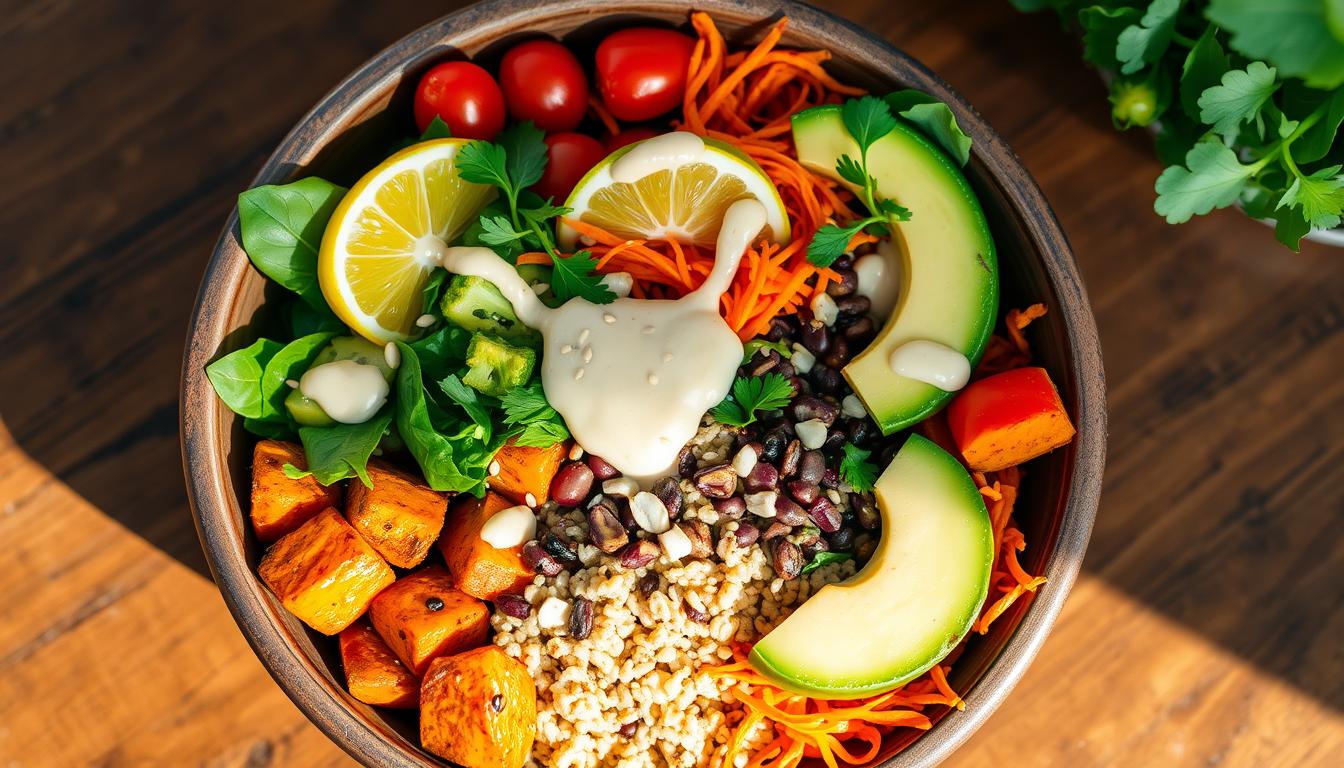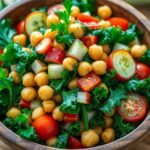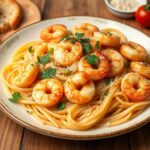Imagine turning your kitchen into a colorful canvas of health and taste. The colorful vegan Buddha bowl with creamy tahini is more than a recipe. It’s a journey that changes how you see healthy eating.
With every bite, you get a story of health. The ingredients work together in perfect harmony. It’s not just food; it’s a celebration of wellness that connects you to nature’s best.
In just 40 minutes, you can make a dish that serves two. It’s filled with quinoa, tofu, pumpkin, and sprouts. These ingredients will excite your taste buds and give you energy from plants.
Key Takeaways
- Create a nutrient-dense meal in under an hour
- Explore the versatility of plant-based ingredients
- Enjoy a gluten-free, protein-rich dining experience
- Learn to balance flavors and textures in one bowl
- Discover the joy of mindful, wholesome cooking
Understanding the Buddha Bowl Phenomenon
Explore the vibrant world of vegetarian cuisine and nutritious bowl meals. Buddha bowls have changed how we eat. They offer more than just food; they are a way to nourish and care for ourselves.
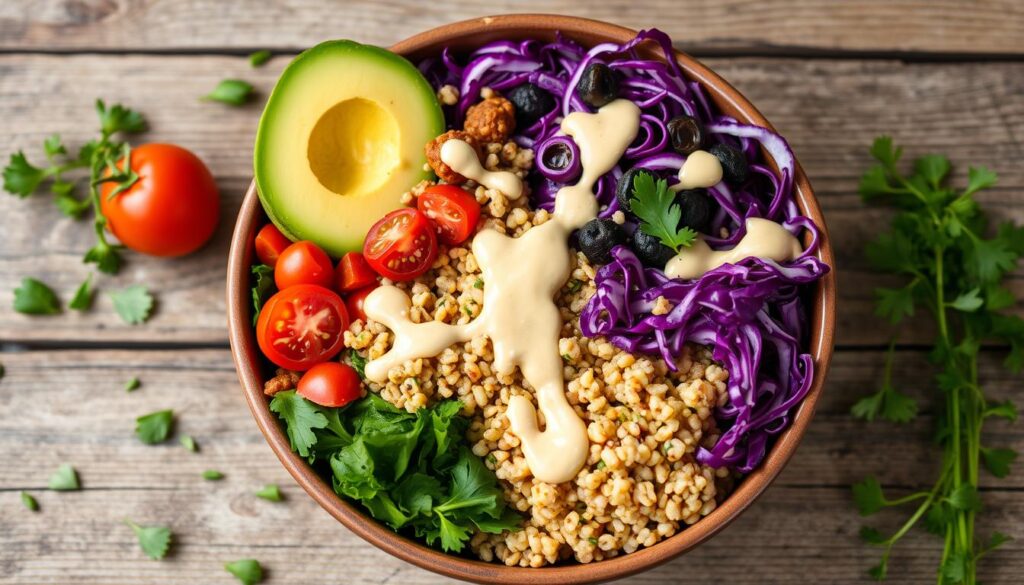
Origins of Buddha Bowls
Buddha bowls come from mindful eating. They focus on balance and a variety of nutrients. These bowls follow ancient traditions, showing us how to eat whole and healthy.
- Originated from Buddhist meditation practices
- Inspired by principles of balanced nutrition
- Embraced by health-conscious food enthusiasts
Why They’re Called Buddha Bowls
The name “Buddha Bowl” comes from their round shape. It reminds us of Buddha’s full belly. These bowls are full of color and nutrients, making every meal a feast for the eyes and body.
“A Buddha Bowl is more than a meal; it’s a celebration of color, nutrition, and mindful eating.”
The Rise of Plant-Based Bowl Meals
Market research shows Buddha bowls are growing fast in our food culture. With 75% of millennials loving colorful vegan dishes and 50% eating mostly plants, these bowls are a big hit.
| Statistic | Percentage |
|---|---|
| Plant-based food sales growth | 300% |
| Consumers viewing Buddha Bowls as convenient | 80% |
| Millennials interested in colorful vegan dishes | 75% |
Discovering Buddha bowls is more than just trying new food. It’s about enjoying the most vibrant and healthy way to eat.
Essential Components of a Perfect Buddha Bowl
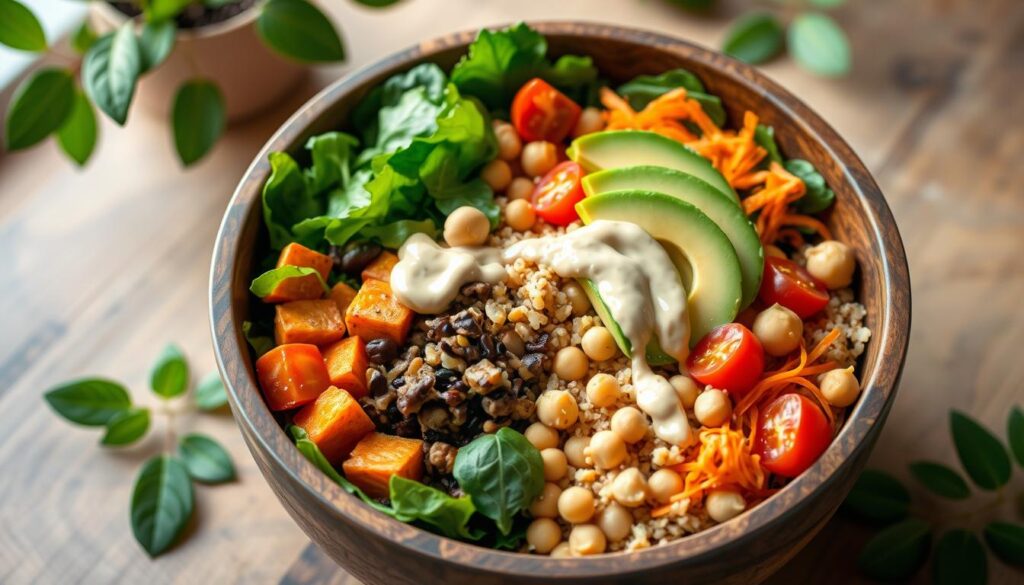
Making a tasty healthy plant-based recipe means knowing what a Buddha bowl needs. These dishes are more than food; they’re a mix of nutrients that feed your body and please your taste buds.
A great Buddha bowl has several key parts. Together, they make a meal that’s both filling and good for you:
- Nutrient-dense grain base (quinoa, brown rice)
- Plant-based protein source
- Roasted or raw vegetables
- Healthy fat components
- Flavorful dressing
Now, let’s look at what a typical Buddha bowl offers nutritionally:
| Nutrient | Amount | Daily Value |
|---|---|---|
| Total Fat | 34g | 52% |
| Dietary Fiber | 36g | 150% |
| Protein | 34g | 68% |
| Vitamin A | 20002 IU | 400% |
“A Buddha Bowl is like a 64-color box of crayons – endless possibilities, vibrant and full of life!”
To make your Buddha bowl, mix different types of ingredients. You want a base, veggies, protein, carbs, something sweet, something crunchy, and a flavor boost. Your goal is to make a meal that looks good and is full of nutrients, satisfying your hunger and taste buds.
The Power of Plant-Based Ingredients
Making a nutritious bowl meal is more than just putting ingredients together. It’s a journey that feeds both your body and soul. Plant-based ingredients are full of nutrients and flavors.
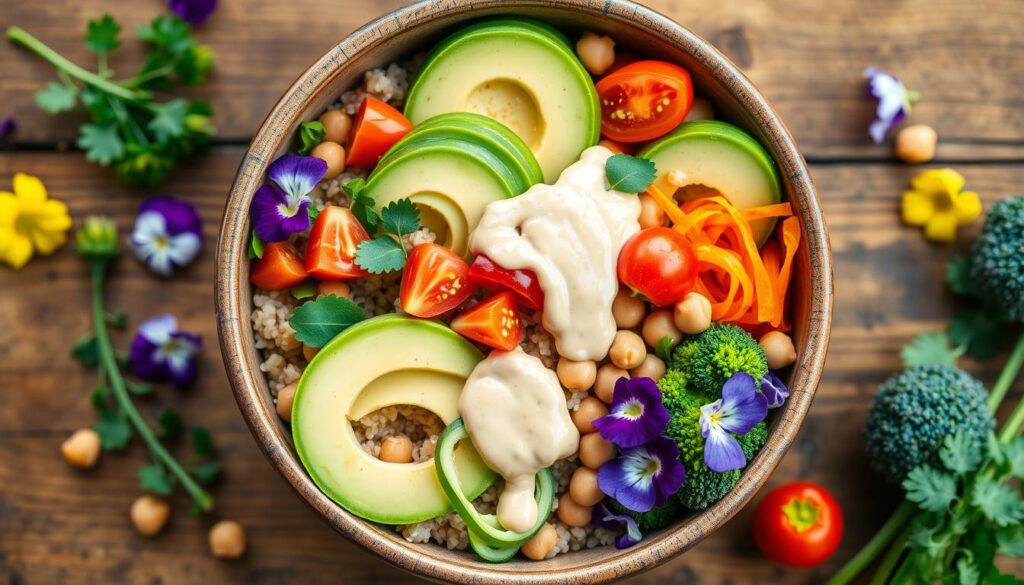
Your plant-powered bowl can change how you see nutrition. Each ingredient has special benefits for your health and well-being.
Nutritional Benefits of Quinoa
Quinoa is a standout because it has all nine essential amino acids. This superfood is packed with nutritional value:
- Complete protein with all essential amino acids
- Rich in fiber (11.01g per serving)
- High in minerals like iron and magnesium
- Supports muscle recovery and energy production
Protein-Rich Plant Sources
Your journey to compassionate eating can include many protein-rich foods. These foods are tasty and good for you:
- Chickpeas: 14.5g protein per cup
- Tofu: Provides 8-15g protein per serving
- Tempeh: Offers 16g protein per 3-ounce serving
- Lentils: Delivers 18g protein per cup
Colorful Vegetable Selection
A variety of vegetables adds nutrients to your meal. Each color brings its own health benefits:
- Green vegetables: Boost immune system
- Orange/Yellow: Support eye health
- Red vegetables: Enhance heart health
- Purple produce: Provide antioxidants
“Eating a variety of colors isn’t just visually appealing—it’s a key strategy for complete nutrition.”
By using these plant-based ingredients, you’re doing more than just cooking. You’re making a meal that’s good for you and supports compassionate eating.
Colorful Vegan Buddha Bowl with Creamy Tahini Bliss
Get ready for a vibrant vegetarian cuisine experience. This colorful vegan buddha bowl with creamy tahini bliss is a nutritional masterpiece. It’s packed with flavor and health benefits.
The star of our buddha bowl combines carefully selected ingredients. They work in perfect harmony. Your culinary journey includes:
- 2 cups cooked red quinoa
- 1 cup French lentils
- 1 cup roasted Brussels sprouts
- 1 cup diced butternut squash
Each serving delivers an impressive nutritional profile:
- Calories: 651 kcal
- Protein: 29g
- Fiber: 22g
- Carbohydrates: 96g
“Food is not just eating. It’s an experience.” – Unknown
Roasting vegetables at 375°F for 20-30 minutes creates a caramelized texture. This elevates the entire bowl. Your homemade creamy tahini sauce will tie everything together, making this a truly blissful meal.
Experts recommend high-fiber diets for numerous health benefits. Clinical trials suggest such diets can help reduce body weight, lower blood pressure, and potentially decrease risks of chronic diseases.
Mastering the Creamy Tahini Sauce
Tahini dressing is the secret to making a Buddha bowl special. It adds depth, creaminess, and nutrition to your dish.
Selecting the Perfect Tahini
Not all tahini is the same. Look for these qualities when picking your sesame seed paste:
- Smooth, runny consistency
- Rich, nutty aroma
- Minimal ingredient list
- Preferably organic and single-origin
Blending to Perfection
For a silky tahini dressing, follow these tips:
- Use room temperature tahini
- Whisk vigorously to prevent separation
- Gradually add water for desired consistency
- Taste and adjust seasoning
Flavor Enhancement Techniques
Boost your tahini dressing with these additions:
- Citrus zest for brightness
- Roasted garlic for depth
- Fresh herbs like cilantro or dill
- Smoked paprika for complexity
“A great tahini dressing can turn simple ingredients into a restaurant-quality meal.” – Plant-Based Chef
Step-by-Step Bowl Assembly Guide
Making the perfect nutritious bowl meal is all about strategy. Your dish will come to life with careful layering and the right ingredients.
- Prepare Your Base
- Cook quinoa with a 1:2 ratio of quinoa to water.
- Let it rest for 5 minutes after cooking.
- Fluff with a fork for a light texture.
- Arrange Colorful Vegetables
- Slice 4 large carrots into thin strips.
- Add 8 cups of fresh spinach.
- Chop cucumber and tomatoes for variety.
- Add Plant-Based Proteins
- Drain and rinse 1 can of chickpeas.
- Sprinkle 1/4 cup sunflower seeds.
- Garnish with 8 chopped basil leaves.
- Finish with Dressing
- Mix 3 tablespoons olive oil.
- Add 3 tablespoons balsamic vinegar.
- Whisk in 3 tablespoons vegan mayonnaise.
Your buddha bowl becomes a vibrant, nutrient-packed meal with these steps. The secret is balancing colors, textures, and flavors for a stunning dish.
“Eating should be a celebration of colors, flavors, and nourishment.” – Plant-Based Chef
Nutrition at a glance:
| Nutrient | Amount |
|---|---|
| Calories | 452 kcal |
| Protein | 12 g |
| Total Carbohydrates | 49 g |
| Total Fat | 25 g |
Enjoy your perfectly assembled meatless delicacy!
Meal Prep and Storage Tips
Starting a compassionate eating plan begins with smart meal prep. A Buddha bowl can be a lifesaver on busy weekdays. It lets you enjoy healthy meals without the daily cooking hassle.
Make-Ahead Components
Preparing your Buddha bowl ingredients ahead of time makes cooking easier. Here are some key parts you can prep in advance:
- Quinoa and grains can be cooked and stored for 4 days
- Roasted vegetables stay fresh in the refrigerator for up to 4 days
- Chickpeas can be roasted and stored at room temperature for one week
- Tahini dressing keeps well in the refrigerator for 10 days
Storage Solutions
Storing your ingredients properly is key to keeping them fresh. Use airtight containers to keep things fresh and prevent moisture buildup.
“Meal prep is not just about saving time, it’s about creating sustainable, nutritious eating habits.”
Reheating Guidelines
Here’s how to reheat your Buddha bowl components:
- Quinoa: Microwave on medium for 2 minutes or reheat on stovetop
- Roasted vegetables: Warm in 350ºF oven for 15 minutes
- Tahini sauce: Add 1-2 teaspoons of water when reheating
By following these tips, you’ll make your compassionate eating journey easier. You’ll always have delicious, nutritious meals ready to go.
Seasonal Variations and Substitutions
Embracing the seasons is key to vibrant vegetarian cuisine. Buddha bowls are perfect for this, letting you change up your recipes with fresh ingredients.
Seasonal ingredients make your Buddha bowls special. Each season brings new produce that can take your dishes to the next level:
- Spring: Fresh asparagus, tender greens, radishes
- Summer: Juicy tomatoes, colorful bell peppers, crisp cucumbers
- Fall: Roasted squash, hearty root vegetables, pomegranate seeds
- Winter: Citrus fruits, kale, roasted Brussels sprouts
Smart swaps can make your nutritious bowl meal versatile. Here are some tips for changing up your ingredients:
| Base | Protein | Seasonal Substitute |
|---|---|---|
| Quinoa | Chickpeas | Farro or barley |
| Brown rice | Tofu | Cauliflower rice |
| Greens | Tempeh | Seasonal leafy alternatives |
Pro tip: Always have versatile ingredients on hand. This way, you can enjoy delicious vegetarian meals all year.
“Seasonal cooking is about celebrating the rhythm of nature through your plate.” – Local Chef Wisdom
Conclusion
Your colorful vegan Buddha bowl is more than a meal. It’s a way to change how you eat and think about food. It’s about nourishing your body and caring for the planet.
The bowl’s layers of quinoa, roasted veggies, and chickpeas show that plant-based food can be tasty and full of nutrients. Each bowl gives you a mix of protein, healthy fats, and carbs. It also lets you try new flavors and use fresh, seasonal ingredients.
Keep making your Buddha bowls your own way. Try new veggies, grains, and proteins. Your path to eating with kindness is special. It lets you make food that’s good for you and the planet.
Creating a colorful vegan Buddha bowl is more than cooking. It’s about enjoying healthy food and being mindful. It’s a celebration of good health and delicious flavors.

